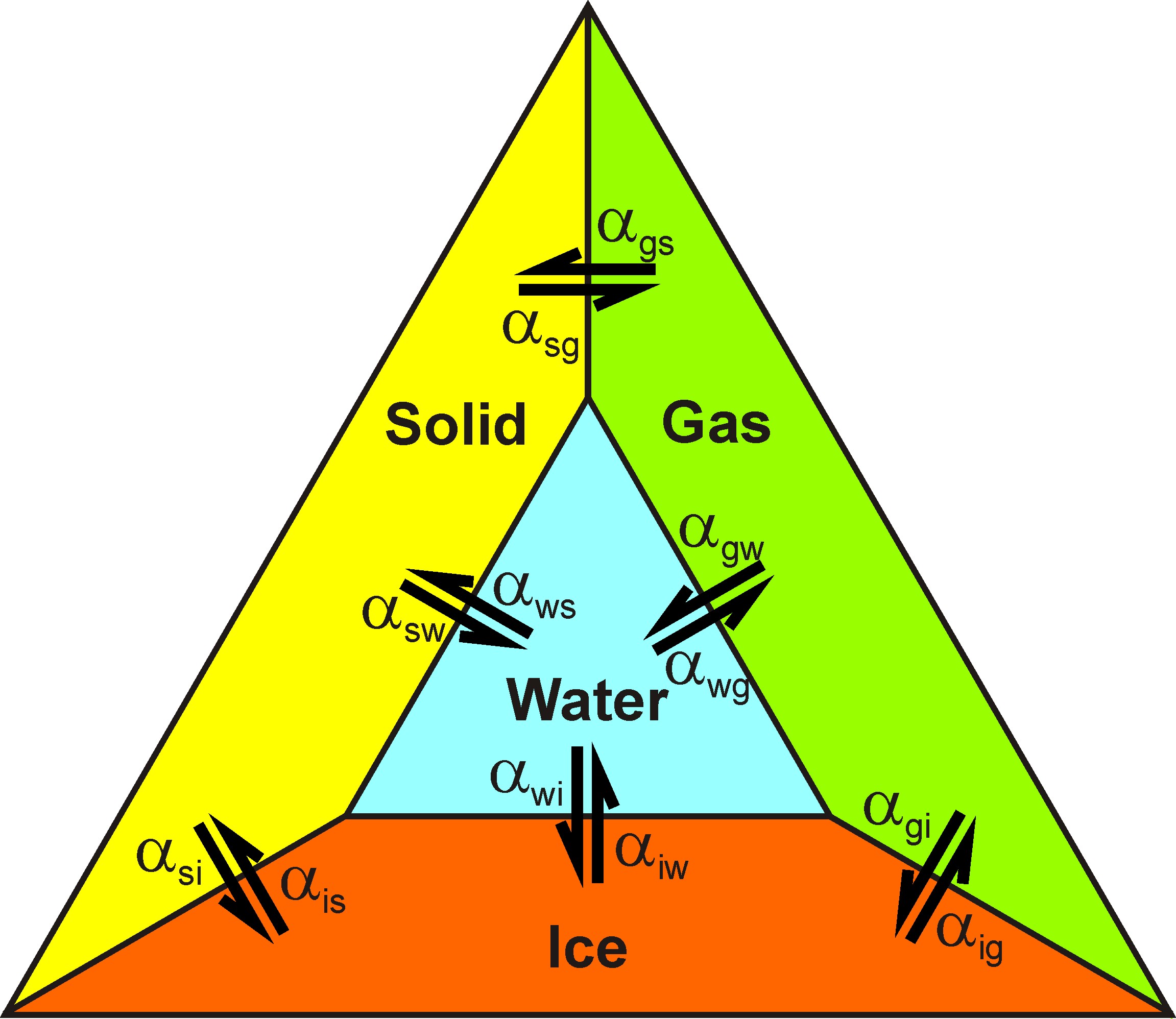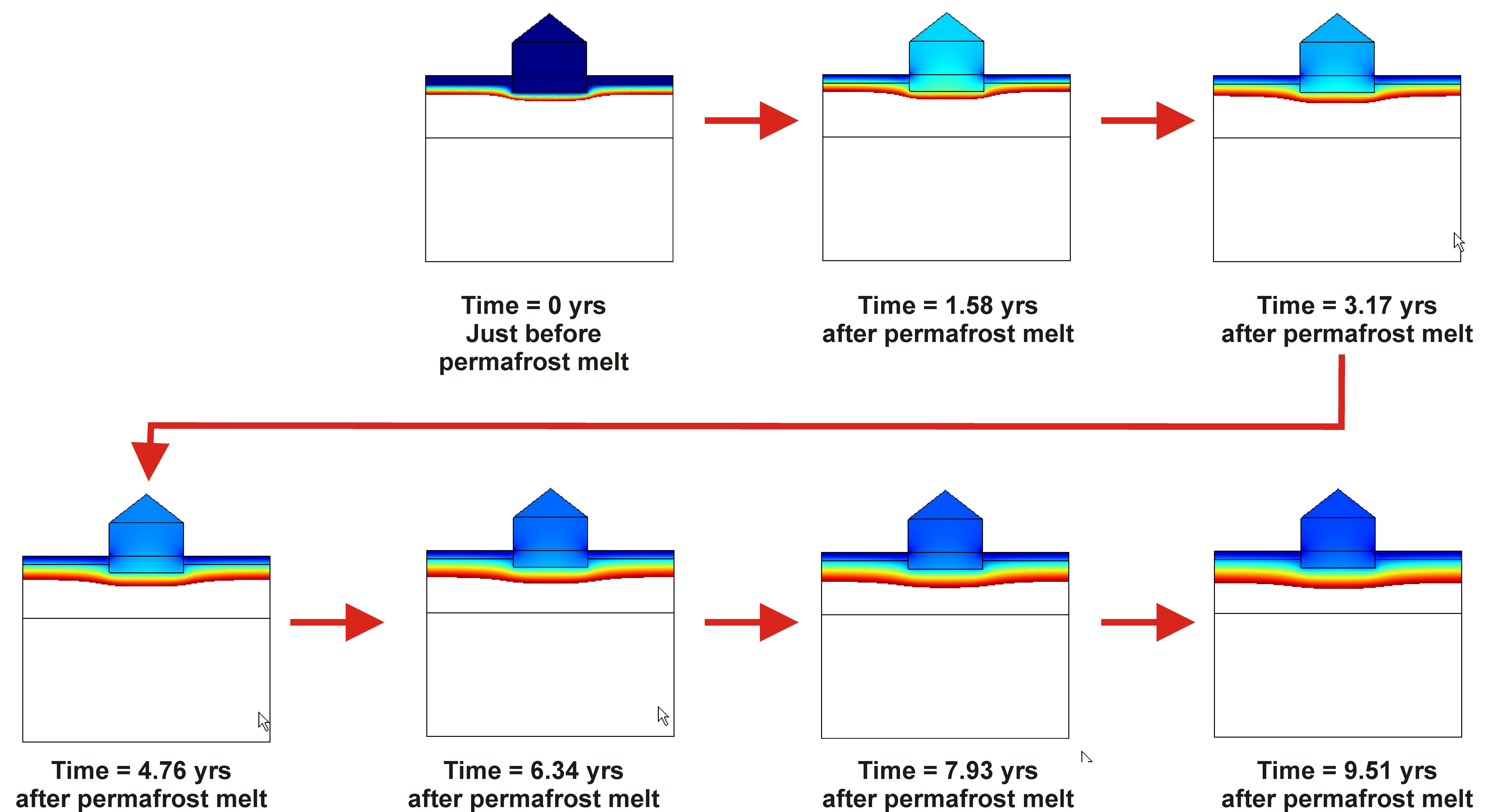

Increased domestic radon exposure caused by permafrost thawing due to global climate change
Radon is a naturally occurring radioactive gas which accounts for approximately 9% of lung cancer deaths in Europe and 12% in the USA, and is considered to be the most serious environmental carcinogen by the EPA. The diffusive and advective transport of radon through the soil is controlled by the porosity, fluid saturations, diffusion coefficients and relative permeabilities of the soil. All of these parameters are significantly reduced in the permafrost that makes up one fifth of the Earth's terrestrial surface.

The advection, diffusion and mass balance partial differential equations that must be solved to model the distribution of radon must take account of the fact that the radon can be distributed among 4 different phases (solid rock matrix, soil gas, water and ice), and that there is an equilibrium reaction between each. We show this as a triangular diagram.
We have extended the 2D numerical modelling of radon transport through soil and permafrost reported at EGU2006 to include gradual as well as instantaneous melting, different designs of ventilated and unventilated building, and diffusive or convective-diffusive transport. We find that the presence of the permafrost acts as an effective radon barrier. For the world average Ra226 activity of 40 Bq/kg, the permafrost seems to reduce the domestic radon concentrations by 80 to 90% (5 to 10 Bq/m3) while leading to an increase in the concentration in the radon behind the barrier by 10 to 15 times (500 to 750 Bq/m3). However, when we modelled the thawing of the permafrost that is beginning to occur as a result of global climate change the radon in the building increased transiently by up to 100 times (1000 Bq/m3) over a timescale of several years before decreasing once again. It is therefore possible that a significant number of people could be exposed to levels of radon in excess of the 200 Bq/m3 threshold that many countries adopt. The inclusion of advection has a time compression effect that has little or no effect on the maximum and final concentrations of radon, or the overall shape of the curve describing the mean radon in the building as a function of time. The inclusion of gradual melting slightly reduces the maximum value of radon present in the building, but not sufficiently to reduce it to a safe level. The form of the radon concentration-time curve is surprisingly similar to the instantaneous case.

The initial radon distribution (red) remains under the permafrost layer. The concentration of radon in the house is negligible (blue).

If the permafrost is suddenly melted, the time sequence below occurs for a diffusion driven system. It can be seen that the house fills with radon within about 1 year, and that the radon takes several more years to dissipate. A slightly different scenario os true if there is additional advection or if the melting is not sudden. Please read the poster for more information.
Bibliography
Glover, P.W.J., Increased domestic radon exposure caused by permafrost thawing due to global climate change, in preparation for Nature.
Glover, P.W.J., Increased domestic radon exposure caused by permafrost thawing due to global climate change, Poster, EGU 2006, EGU06-A-01439, 2-7 April 2006. [pdf]
Glover, P.W.J. & Blouin, M., Modelling increased soil radon emanation caused by instantaneous and gradual permafrost thawing due to global climate warming, Poster, EGU 2007, EGU2007-A-07657, 15-20 April 2007. [pdf]
Glover, P.W.J. & Blouin, M., Modeling increased soil radon emanation caused by instantaneous and gradual permafrost thawing due to global climate warming, Poster, GAC-MAC 2008, Résumé No. 63, 26-28 May 2008. [pdf]
Cliche, J.-F. (and Glover, P.W.J.), La fonte du pergelisol, une menace pour la santé, LeSoeil, 31 mai 2008 - Newpaper article. [pdf]
© Copyright, Paul Glover 2008: Last updated 14/11/2008